
|
Old Testament
New Testament
Gospels
Acts
Paul's Letters
General Letters
Revelation
Topical Studies
Beginning the Journey (for new Christians). en Español

|
Old Testament
New Testament
Gospels
Acts
Paul's Letters
General Letters
Revelation
Topical Studies

|
Home
Bible Studies
Articles
Books
Podcasts
Search
Menu
Donate
About Us
Contact Us
FAQ
Sitemap
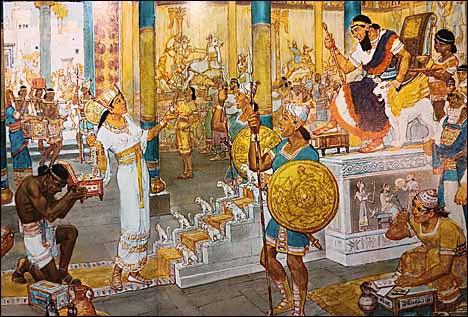 Henry J. Soulen, 'Queen of Sheba Visits Solomon' (1967), illustration in Everyday Life in Bible Times (National Geographic Society, 1967), pp. 230-231. A similar scene by Edward John Poynter is in Section 5.4 below. |
When Yahweh appears to Solomon at Gibeon in a dream, he asked Solomon,
"Ask for whatever you want me to give you." (1 Kings 3:5, Lesson 2.2)
Solomon requests wisdom so he can govern God's people well. It pleases God and displays the purity of Solomon's heart. God promises great wisdom, and continues:
"Moreover, I will give you what you have not asked for -- both riches and honor--so that in your lifetime you will have no equal among kings." (1 Kings 3:13)
We considered Solomon's wisdom in Lesson 2. Here we'll see the riches and honor that God bestows upon him in fulfillment of his promise. We'll also compare the opulence of Solomon's throne room to God's, and consider a Christian view of wealth.
5.1 Palaces (1 Kings 7:1-12)
Solomon is a builder. After seven years constructing the temple, he builds an elaborate palace that takes thirteen additional years193 (1 Kings 7:1; 9:10).
Solomon's Palace (1 Kings 7:1-12)
We skipped over the building of Solomon's palace where it occurred in the text of 1 Kings 7 (Lesson 3.4), so we could focus on the temple furnishings. Now let's come back to it.
Solomon's palace takes longer to build than the temple because it is substantially larger. While the temple with its porch is 105 feet (32 meters) long, Solomon's palace is 150 feet long (46 meters). The palace grounds also feature a covered colonnade 75 feet long (23 m.) and 45 feet wide (14 m.) (1 Kings 7:1-6).
Solomon seems to have built several primary structures in the royal compound.
- The Palace of the Forest of Lebanon where he and perhaps his harem live, named for all the cedar columns, beams, ceiling joists, and paneling (1 Kings 7:2-5, 8). This also seems to serve as an armory for the storage of weapons,194 as well as Solomon's treasure and precious goblets and serving utensils of gold.195
- A covered colonnade (1 Kings 7:6).
- The Throne Hall, the Hall of Justice was constructed where Solomon holds court, governs, and renders judicial rulings for the harder cases of his people (1 Kings 7:7).
- Palace for Pharaoh's daughter, who appears to be his chief wife (1 Kings 7:8b).
Though we aren't given all the details, the dimensions of his palace are impressive, built of massive cut limestone blocks (1 Kings 7:9; see Lesson 3.3). Some of the foundation stones were 12 to 15 feet wide (3.7 to 4.6 m.; 1 Kings 7:10). There is no skimping on cedar, a high-end imported building material.
Palace for Solomon's Wife, Daughter of Pharaoh (1 Kings 7:8b)
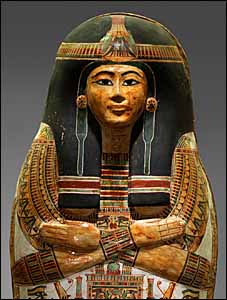 Henettawy, Mistress of the House, Singer of Amun-Re, Egypt, 21st Dynasty, outer coffin, Metropolitan Museum of Art, New York, Gallery 126. She is from the same dynasty as Solomon's wife. Larger image. |
Four times in 1 Kings, the text informs us that Solomon has married the daughter of Pharaoh, king of Egypt, probably, Siamun, a Pharaoh of the 21st dynasty (978-959 BC)196 or his successor Psusennes II (959-945 BC).197
"Solomon made an alliance with Pharaoh king of Egypt and married his daughter. He brought her to the City of David until he finished building his palace and the temple of the Lord, and the wall around Jerusalem." (1 Kings 3:1)
As we observed in Lesson 2.1, such a marriage to a non-Jew is prohibited in the Law. Nevertheless, marriages of sons and daughters of kings of surrounding kingdoms was not uncommon.
For a daughter of a Pharaoh to be married to a king outside of Egypt, however, is rare; it is considered a great honor for Solomon, though it may also indicate Egypt's weakness at this time. On the other hand, an alliance with Solomon is considered important enough to Egypt that the Philistine city of Gezer that Egypt has conquered is given as a wedding gift to his daughter; Solomon later rebuilds the city (1 Kings 9:16-17).
Since Egypt is an important ally, Pharaoh's daughter seems to be accorded her own palace and special status among Solomon's wives (1 Kings 7:8).
Apparently, it was thought improper for the daughter of a pagan king to live within the holy precincts of the City of David where David had pitched a tent for the ark (2 Chronicles 9:11; cf. 1 Kings 9:24). Her palace seems to have been built within Solomon's palace complex just south of the temple, though we're not told its exact location. 198
5.2 Solomon's Other Building Projects (1 Kings 9:10-28; 2 Chronicles 9:10-18)
Many of Solomon's building projects are designed to shore up defenses of Jerusalem and key locations that guard access to the central Judean highlands.
Construction of Jerusalem's Wall and Repair of the Millo
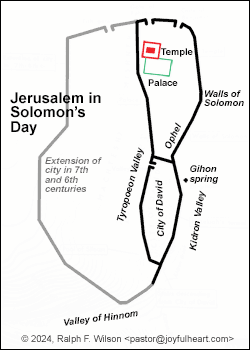 Jerusalem in Solomon's Day (larger map) |
Many of Solomon's building projects use conscripted labor: the temple, his palaces, "the supporting terraces (millôʾ), the wall of Jerusalem, and Hazor, Megiddo and Gezer" (1 Kings 9:15b; cf. 3:1).
Israeli archeologist Eliat Mazer claims to have identified a large wall in Jerusalem going back to Solomon's time, 230 feet long (70 m.) and 20 feet high (6 m.) between the temple mount and the ancient city of David. The wall is part of a defensive complex that includes a gatehouse, an adjacent building, and a guard tower.199
"Supporting terraces" (NIV), "Millo" (ESV, NRSV, KJV) is the noun millôʾ, "filled, mound, rampart," something that fills a gap or hole, from the verb mālēʾ, "to fill."200 We read that:
"Solomon had built the supporting terraces and had filled in the gap201 in the wall of the city of David his father." (1 Kings 11:27)
Exactly what the Millo was -- even the exact location -- is disputed. Apparently, it constitutes a part of the defenses of Jerusalem "especially constructed for the defense of a vulnerable spot." After David captures Jerusalem from the Jebusites, he works on the Millo to strengthen the city's defenses (2 Samuel 5:9; 1 Chronicles 11:8). Later, Solomon repairs or rebuilds the Millo (1 Kings 3:1).202
Border Villages Given to Hiram (2 Chronicles 9:10; 1 Kings 9:11-14)
The original building contract with Hiram, king of Tyre, for the beams, paneling, and laborers for building the temple itself apparently isn't enough to cover both that and all Solomon's other palaces and building projects. At some point, Solomon pays Hiram with twenty Galilean villages, probably near the Bay of Acre, on the border between Israel and Tyre (1 Kings 9:11).203
However, Hiram doesn't seem happy with the exchange: "'What kind of towns are these you have given me, my brother?' he asked. And he called them the Land of Cabul, a name they have to this day." (1 Kings 9:13). "Cabul" may refer by popular etymology to the adjective keḇal, "as old, as worn out."204 Hiram may have been particularly angry because part of the deal included 120 talents of gold (verse 14) -- an immense fortune! (See Lesson 5.5 below.)205
A brief verse from the Chronicler is difficult to understand, since it stands alone without context.
"Solomon rebuilt the villages that Hiram had given him, and settled Israelites in them." (2 Chronicles 9:10)
Selman concludes that either the villages were returned to Solomon because they were unacceptable or because they were collateral for a loan that had been repaid.206
The Philistine City of Gezer (1 King 9:16-17a)
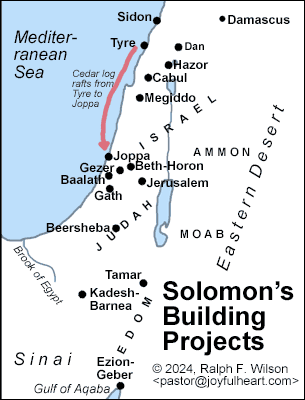 Solomon's Building Projects (larger map) |
Solomon rebuilds Gezer.
"Pharaoh king of Egypt had attacked and captured ed Gezer. He had set it on fire. He killed its Canaanite inhabitants and then gave it as a wedding gift to his daughter, Solomon's wife. And Solomon rebuilt Gezer." (1 Kings 9:16-17a)
Bright speculates that Pharaoh Siamun, a relatively weak king of Egypt, launches a campaign against Philistine cities over which he claims suzerainty, but needs to withdraw when he sees the size of Solomon's army. The conquered city and his daughter as Solomon's wife become the price of peace.207 Under Solomon, a fortified Gezer defends the southwest approaches to the interior of Israel from Philistia.208
Fortified Cities and Store Cities (1 Kings 9:15, 17-19; 2 Chronicles 8:3-6)
As mentioned in Lesson 3.2, Solomon's building projects are conducted by slave labor from the descendants of Canaanite tribes that Joshua didn't wipe out during the Conquest (1 Kings 9:20-21). Citizens of Israel take part in building projects one month out of three, and become
"[Solomon's] fighting men, his government officials, his officers, his captains, and the commanders of his chariots and charioteers. They were also the chief officials in charge of Solomon's projects -- 550 officials supervising the men who did the work." (1 Kings 9:22--23; cf. 2 Chronicles 9:7-10)
Though Solomon is no warrior, he wisely fortifies Jerusalem and other key cities that are strategic to protecting the homeland. He maintains a considerable standing army that garrisons the fortified cities. Thus, Bright reminds us, "Solomon's army could be marshaled quickly for defense against invasion, for quelling internal uprisings, or for operations against rebellious vassals."209 These cities included:
Hazor (1 Kings 9:15), an ancient city north of the Sea of Galilee. Solomon fortifies it to protect his kingdom from attack from the north.210
Megiddo (1 Kings 9:15), an ancient royal Canaanite city overlooking the Valley of Jezreel, is a strategic location refortified by Solomon to defend his kingdom from the west, the road from Phoenicia through the Carmel Valley.211
Hamath Zobah. "Solomon then went to Hamath Zobah and captured it" (2 Chronicles 8:3). We're not sure what city this refers to, though that hasn't halted speculation.212
Beth Horon (1 Kings 9:17; 2 Chronicles 8:5) consists of two towns. Upper Beth-Horon is at an elevation 2,022 ft (616 m.); Lower Beth Horon is at an elevation of 1,210 feet (369 m.). Together they are strategic to guarding a rugged and steep pass along the great highway through the Ayalon Valley from the plain into the mountainous plateau in central Judea. Solomon rebuilds them "with walls and with gates and bars" (2 Chronicles 8:5) to protect his kingdom.213]213
Baalath (1 Kings 9:18; 2 Chronicles 8:6) is a town on the border of Dan, developed as one of Solomon's store-cities.214
Tamar (1 Kings 9:18; 2 Chronicles 8:4) apparently refers to an obscure Judean town in the Negev desert south of the Dead Sea on the traditional border between Judah and Edom, the present-day village 'Ain Husb. However, some identify it as the ancient trading city of Tadmor (Palmyra) in the Syrian desert north of Damascus.215
Chariot cities (1 Kings 9:19; 2 Chronicles 8:6). See Lesson 5.5 below on 1 Kings 10:28-29.
Q18. Which of Solomon's building projects are designed
to glorify Yahweh? Which are designed to glorify Solomon? Which are designed to
provide protection and security for his people? Many of God's people are in day-to-day
provision mode, but if God has given you a bit of disposable income, which of
your primary financial outlays are designed to honor God? Which are designed to
serve others?
https://www.joyfulheart.com/forums/topic/2261-q18-glorify/
5.3 Ships and Trade (1 Kings 9:26-28; 2 Chronicles 8:17-18)
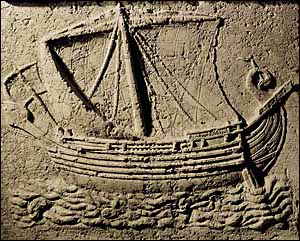 Phoenician ship carved on a sarcophagus, 2nd century AD. From the old port of Sidon in Lebanon, now in Musee du Louvre, Paris. Larger image |
Solomon and Hiram King of Tyre develop mutually lucrative trade that began in David's time and continues.
At this time, the Phoenicians are in the earlier stages of their domination of Mediterranean trade. Hiram seems to be a vassal king under Solomon, but the relationship seems like a true partnership.
Solomon, the ruler of an adjacent country and one of the wealthiest kings in the world, provides capital for Hiram's shipbuilding, a ready market for goods, and perhaps favorable treatment on tariffs that Solomon charges commercial caravans that travel through the lands he controls.
The Phoenicians have a lot to offer Solomon -- three good Mediterranean ports -- Tyre, Sidon, and the island of Awrad. Israel possesses only Joppa, which never became a major seaport. Israel can provide access to the Red Sea for Phoenician traders.
Hiram thus builds Solomon two fleets of trading vessels for joint ventures with the Phoenicians: (1) Mediterranean trade from Israel's port at Joppa; and (2) trade with Arabia, India, and southeast Asia from Ezion-Geber on the Gulf of Aqaba at the northern tip of the Red Sea. The "trading ships" (NIV) were called "ships of Tarshish" (ESV, NRSV, KJV), probably because the Phoenicians used them to trade as far as Tarshish.216
Mediterranean Fleet
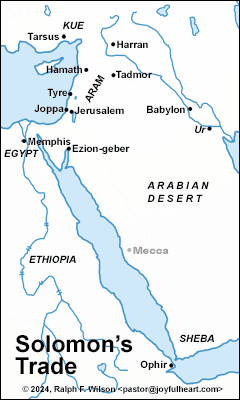 Solomon's Trade (Larger map) |
When Solomon partners with Hiram, Israel becomes part of a complex trading network developed by the Phoenicians that spans the Mediterranean. It also imports goods from Africa that have been floated down the Nile from Kush, Nubia, and Ethiopia to Egyptian ports. Kush, for example, exports gold, ivory, ebony, incense, spices, and iron products.
"The king had a fleet of trading ships at sea along with the ships of Hiram. Once every three yearsears217 it returned, carrying gold, silver and ivory, and apes and baboons." (1 Kings 10:22; cf. 2 Chronicles 9:21)
Gold. The Bible mentions that gold is imported from Ophir, Havilah, Sheba, Raamah, and Uphaz, though some of these locations are unknown today. (See the map "Gold-Bearing Regions (Arabian-Nubian Shield)" in Lesson 5.5 below.) The Phoenicians buy Nubian gold from Egypt, as well as gold, silver, copper, iron, tin, and lead from the Iberian peninsula (Spain).218
Silver is imported from Tarshish and perhaps elsewhere. Copper and tin are sought to be smelted into bronze.
Ivory. Ivory comes from elephant tusks and hippopotamus teeth. It is imported from Africa and India. Asian elephants were once found in Syria, but went extinct. Ivory was used in ornaments, fashioned into works of art, inlayed into metals or wood, and for combs, hairpins, amulets, etc.219
Apes may refer to the Hamadryas Baboon (Papio hamadryas), native to the horn of Africa and southwestern Arabia.220 They are imported for the entertainment of the wealthy.
Baboons or peacocks. Depending on how one derives the Hebrew loan-word tūkkîyîm in 1 Kings 10:22, this could refer to baboons or apes from Egypt, or peacocks from India or Southeast Asia.221 These beautiful exotic birds would be found in the estates of the wealthy.
Red Sea Fleet
In addition to his Mediterranean fleet, Solomon partners with Hiram to develop a shipyard and port on the Red Sea, where he constructs ships, probably with materials brought from Tyre (2 Chronicles 8:18). Philo of Byblos (AD 64-141) quotes the Phoenician historian Sanchuniathon to the effect that Hiram sent 800 camels loaded with timber to Ezion-Geber for building ten ships.222
"26 King Solomon also built ships at Ezion Geber, which is near Elath in Edom, on the shore of the Red Sea. 27 And Hiram sent his men -- sailors who knew the sea -- to serve in the fleet with Solomon's men. 28 They sailed to Ophir and brought back223 420 talents of gold, which they delivered to King Solomon." (1 Kings 9:26--28)
"Hiram's ships brought gold from Ophir; and from there they brought great cargoes of almug wood and precious stones." (1 Kings 10:11)
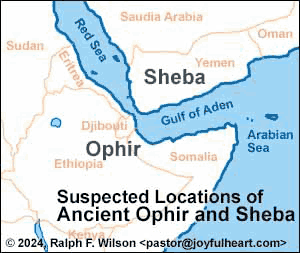 Suspected Locations of Ancient Ophir and Sheba (larger map) |
The exact location of Ophir is unknown, but probably is in the south Arabian peninsula or East Africa.224 The best guess of Ophir's location is in the area of present-day Ethiopia, Eritrea, Somalia, and Djibouti.225
Algum may be red sandalwood (Pterocarpus santalinus), though we're not sure. The tree is indigenous to India or Ceylon. Solomon uses algum for construction in the temple and palace, and to make instruments for musicians (1 Kings 10:11).226
This joint trading venture out of the port of Ezion Geber gives Solomon and his Phoenician partners access to sea trade in Ophir, Sheba, Arabia and Egypt, as well as markets as far as West Africa. India and Southeast Asia.
5.4 Queen of Sheba Visits Solomon (1 Kings 10:1-13; 2 Chronicles 9:1-12)
The visit of the Queen of Sheba to Solomon seems to be included in the account to illustrate both Solomon's great wealth and the esteem with which he was held by other rulers of his day (1 Kings 4:31, 34).
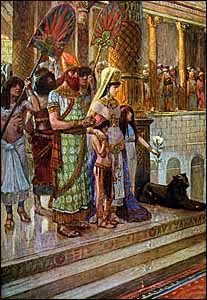 James J. Tissot, 'Solomon and the Queen of Sheba" (1896-1903), gouache on board, The Jewish Museum, New York, NY. Larger image. |
She is Queen of the Sabean peoples, a Semitic tribe that has close contacts with Africa (Isaiah 45:14). Ancient Sheba seems to be the site of present-day Yemen in southern Arabia, across the Bab al-Mandab Strait from the legendary land of Ophir on the horn of Africa.
Sheba had long traded in frankincense, myrrh, spices, aromatic wood, and gold.old.227 Our passage probably suggests negotiation of commercial agreements and treaties regulating trade routes and sea lanes, since Sheba transports various kinds of goods to the Mediterranean through lands controlled by Solomon, where he would gain tariff revenue.228
The Queen of Sheba makes quite an entrance into Jerusalem.
"1 When the queen of Sheba heard about the fame of Solomon and his relation to the name of the Lord, she came to test him with hard questions. 2 Arriving at Jerusalem with a very great caravan--with camels carrying spices, large quantities of gold, and precious stones." (1 Kings 10:1-2)
The Queen of Sheba asks hard questions229 -- not just riddles, but also difficult diplomatic and ethical questions230 -- and hears Solomon's wise answers and explanations. His wise words, as well as the organization of his bureaucracy, his piety in offering sacrifices, and the impressiveness of the temple and palaces are overwhelming to this desert queen. Before visiting, it was hard for her to believe the reports, but now that she has seen them, she has nothing but praise (1 Kings 10:3-8). She concludes with praise for Solomon's God.
"Praise be to the Lord your God, who has delighted in you and placed you on the throne of Israel.231 Because of the Lord's eternal love for Israel, he has made you king, to maintain justice and righteousness." (1 Kings 10:9)
The Queen of Sheba gives Solomon large quantities of spices and 120 talents of gold that constitute a huge fortune, millions of dollars in today's money (See Lesson 5.5 below).232 The text doesn't say so, but the gifts may have been more than altruistic. When you make friends with a great regional power, you help guarantee favorable trade treatment.233
The Queen of Sheba congratulates Solomon's people for their good fortune in having him as king.
"How happy your men must be! How happy your officials, who continually stand before you and hear your wisdom!" (1 Kings 10:8)
One Greater than Solomon (Luke 11:31)
The story of the Queen of Sheba is familiar to Jesus' hearers 900 years later, for the Master tells his hearers:
"31 The Queen of the South will rise at the judgment with the men of this generation and condemn them; for she came from the ends of the earth to listen to Solomon's wisdom, and now one greater than Solomon is here." (Luke 11:31)
Jesus' point is that, if foreigners recognize true wisdom and repent when truth is preached to them, how much more should Jews recognize the Messiah who is teaching and ministering in their very midst? And yet they reject him. What excuse will our friends and neighbors have on Judgment Day, when they find that the Jesus they neglect is now their Judge? God holds us responsible to respond to the light we have in Jesus -- and to point others to that light.
The Wisdom of Jesus
How much more blessed are we who hear wisdom from Jesus (1 Corinthians 1:30), who can commune with God through the Holy Spirit and enable us to know the mind of Christ (1 Corinthians 2:10-16).
It is easy for us to be impressed by the wisdom and sophistication of our world, by the deep understanding of renowned men and women who no longer believe that Jesus is God in the flesh. Subtle philosophies and values can lead us away from Jesus as our center.
It is so like Jesus to turn common wisdom on its head. His wisdom is often counterintuitive, a study in contrasts. For example:
"Blessed are the meek, for they will inherit the earth" (Matthew 5:5).
"The last will be first, and the first will be last." (Matthew 20:16)
"Love your enemies and pray for those who persecute you." (Matthew 5:44)
"For whoever wants to save his life will lose
it,
but whoever loses his life for me will find it." (Matthew 16:25)
"Whoever wants to become great among you must
be your servant,
and whoever wants to be first must be slave of all." (Mark 10:43--44)
In Corinth, a crucible for Greek thought and philosophy, Paul urges believers to understand Jesus as the true wisdom:
"It is because of him that you are in Christ Jesus, who has become for us wisdom from God -- that is, our righteousness, holiness and redemption." (1 Corinthians 1:30)
Christ's wisdom is our wisdom.
"... Christ in whom are hidden all the treasures of wisdom and knowledge. I tell you this so that no one may deceive you by fine-sounding arguments." (Colossians 2:2b-4)
Without repentance and deep humility, we won't admit that our own wisdom is faulty and leading us in wrong directions. To receive true wisdom, we need God's Spirit.
"The man without the Spirit does not accept the things that come from the Spirit of God, for they are foolishness to him, and he cannot understand them, because they are spiritually discerned." (1 Corinthians 2:14)
Solomon got it right in this proverb, however:
"The fear of the Lord is the beginning of wisdom,
and knowledge of the Holy One is understanding." (Proverbs 9:10)
Jesus is greater than Solomon, wiser than Solomon, greater than all the so-called wise of our world. And if you let Jesus be your wisdom, your guide, your standard of truth, he will guide you through this life and into the next with surety!
"If any of you lacks wisdom, he should ask God, who gives generously to all without finding fault, and it will be given to him." (James 1:5)
Q19. (Luke 11:31; 1 Corinthians 1:30; Colossians 2:2) How
does Jesus' wisdom contrast with worldly wisdom? In what sense are "all the
treasures of wisdom and knowledge" hidden in Him? Just how do you go about
becoming "wise" in Jesus?
https://www.joyfulheart.com/forums/topic/2262-q19-wisdom/
5.5 Solomon's Splendor (1 Kings 10:14-29; 2 Chronicles 9:13-28)
The poor and struggling often resent the wealthy. It happens when they've been exploited by a rich landowner or company owner. But much of that resentment finds its roots in jealousy and greed as we both admire and look down on "the lifestyles of the rich and famous."234 Envy says, "They don't deserve it as much as I do!" Sometimes our own desire to be wealthy shows through (1 Timothy 6:9-10).
We may be tempted to fault Solomon for his ostentation and extreme wealth. But we must be careful, since God doesn't criticize him for this. You may recall Solomon's dream, when God says:
"I will give you what you have not asked for -- both riches and honor -- so that in your lifetime you will have no equal among kings." (1 Kings 3:13)
Even though it may be hard for us, we must understand Solomon's extreme wealth as a reflection of the ultimate wealth of our God who blesses Solomon materially. We must see Solomon's prosperity as a praise to Yahweh.
That doesn't mean, however, that riches always reflect God's blessing. They don't! Indeed, many of the ungodly are rich. Nor must we believe that Solomon always responds to his wealth appropriately. We'll talk about that in a moment, as well as our own temptations to glory and wealth.
Solomon's Gold Tribute and Revenue (1 Kings 10:14-17; 2 Chronicles 9:13-20)
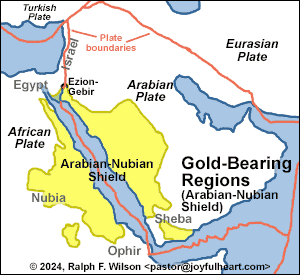 Gold-Bearing Regions (Arabian-Nubian Shield). Larger map. |
As mentioned in Lesson 5.3 above, gold is imported from the Red Sea region on the fleet of ships Solomon builds in partnership with Hiram of Tyre. Present-day geologists have found rich gold deposits in a geologic formation known as the Arabian-Nubian Shield astride both east and west flanks of the Red Sea.235 Precious and industrial metals, including gold, silver, copper, zinc, tin, and lead, have been mined in Saudi Arabia for at least 5,000 years. Nubian gold was exploited by ancient Egypt from Ethiopia and Sudan.
Solomon controls the countries that surround Israel, he receives both annual tribute from these vassal nations, as well as revenues from tariffs assessed on caravans that travel the ancient trade routes passing through these nations, as well as trade that passes through Israel bound for ports on the Mediterranean and the Red Sea.
"14 The weight of the gold that Solomon received yearly was 666 talents, 15 not including the revenues from merchants and traders and from all the Arabian kings and the governors of the land." (1 Kings 10:14--15)
Let's calculate what that amounts to in today's money. The talent, a basic weight of gold or silver, was the largest measure in use before the introduction of coins. The Babylonian talent that was probably used in ancient Israel weighed 129 pounds (58.9 kg).236 Thus, 666 talents, Solomon's annual tribute, would have weighed 85,914 pounds (about 43 tons; 38,970 kg). In January 2024, the price of gold was about $2,000 USD per ounce, making the present-day monetary value of Solomon's annual tribute about $2.7 trillion USD. As early as 1,500 BC, gold was being cast into metal bars, ingots, tongues, and animal heads, in addition to flat discs and rings made of gold, so it could be transported and exchanged in commercial transactions.237]
Solomon is wealthy beyond all proportion. He doesn't seem to know what to spend all his wealth on, so he fashions the gold and silver into shields that adorn his palace (1 Kings 10:16--17).
Solomon's Great Throne (1 Kings 10:18-20)
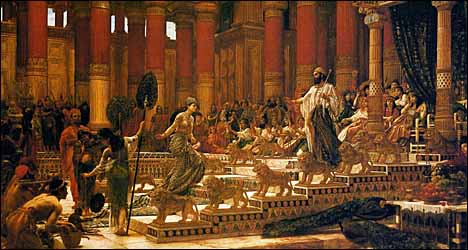 Edward John Poynter, detail of 'The Visit of the Queen of Sheba to King Solomon' (1881-90), oil on canvas, 234.5 x 350.5 cm, Art Gallery of New South Wales, Sydney, Australia. Larger image. This painting captures the opulence of King Solomon's throne and court. |
Solomon's throne is spectacular, made to impress the supplicant standing at its foot.
"18 Then the king made a great throne inlaid with ivory and overlaid with fine gold. 19 The throne had six steps, and its back had a rounded top. On both sides of the seat were armrests, with a lion standing beside each of them. 20 Twelve lions stood on the six steps, one at either end of each step. Nothing like it had ever been made for any other kingdom." (1 Kings 10:18-20)
As mentioned above (Lesson 5.3), ivory comes from the tusks of elephants and the teeth of the hippopotamus, imported from Africa and India. It is beautiful but extremely expensive, used mainly for small objects. Ivory inlay in a large, gold-plated throne would indeed be impressive.
The Throne of God
Solomon's throne is awe-inspiring, but it pales before the throne of God. The Bible contains several visions of Yahweh's throne, where he sits "high and lifted up" (Isaiah 6:1). Yahweh says,
"Heaven is my throne,
and the earth is my footstool." (Isaiah 66:1; cf. Matthew 5:34; Acts 7:49)
In Ezekiel it is described as a throne of sapphires (Ezekiel 10:1). Jesus calls it a "glorious throne" (Matthew 25:31). Hebrews calls it "the throne of grace" (Hebrews 4:16), and refers to it again and again (Hebrews 8:1; 12:2).
John the Revelator has a vision of the heavenly throne room.
"2 Behold, a throne stood in heaven, with one seated on the throne. 3 And he who sat there had the appearance of jasper and carnelian, and around the throne was a rainbow that had the appearance of an emerald. 4 Around the throne were twenty-four thrones, and seated on the thrones were twenty-four elders, clothed in white garments, with golden crowns on their heads. 5 From the throne came flashes of lightning, and rumblings and peals of thunder, and before the throne were burning seven torches of fire, which are the seven spirits of God, 6 and before the throne there was as it were a sea of glass, like crystal. And around the throne, on each side of the throne, are four living creatures, full of eyes in front and behind." (Revelation 4:2-6)
Later,
"The Lamb in the midst of the throne will be
their shepherd,
and he will guide them to springs of living water,
and God will wipe away every tear from their eyes." (Revelation 7:17)
Still later, he sees the Great White Judgment Seat of God.
"11 Then I saw a great white throne and him who was seated on it. From his presence earth and sky fled away, and no place was found for them. 12 And I saw the dead, great and small, standing before the throne, and books were opened. Then another book was opened, which is the book of life. And the dead were judged by what was written in the books, according to what they had done." (Revelation 20:11-12)
Finally, the throne becomes the source and center of life for all.
"1 Then the angel showed me the river of the water of life, bright as crystal, flowing from the throne of God and of the Lamb.... 3 No longer will there be anything accursed, but the throne of God and of the Lamb will be in it, and his servants will worship him." (Revelation 22:1, 3)
Solomon's throne is stupendous, but there are no words to describe God's throne on high.
Solomon's Chariots and Horses (1 Kings 10:26-29)
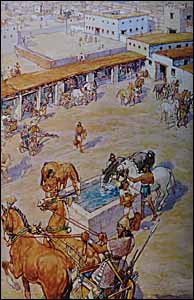 Henry J. Soulen, 'Solomon's Chariot Stables in Megiddo' (1967), detail of illustration in Everyday Life in Bible Times (National Geographic Society, 1967), p. 232. |
Let's skip forward for a moment to verses 26-29 that tell of Solomon's horses and chariots -- part of his wealth. As indicated in Lesson 2.5, the chariot is considered the premier war machine of Solomon's time, extremely useful in valleys and plains, if not on the difficult roads through the Judean hills (Judges 1:19). Israel had been late to adopt them, but Solomon acquires chariots and horses on a large scale and builds cities to accommodate them (1 Kings 4:26; 10:26). Solomon imports horses and chariots from Egypt and Kue (Cilicia, present-day south Turkey), and trades in these weapons of war -- at a tidy profit -- to those he chooses -- the Hittites and Syrians (1 Kings 10:28-29).238 However, I can't help but recall the warning of Deuteronomy:
"16 The king ... must not acquire great numbers of horses for himself.... He must not take many wives, or his heart will be led astray. He must not accumulate large amounts of silver and gold." (Deuteronomy 17:16--17)
Summary of Solomon's Wealth and Power (1 Kings 10:21-25)
Now we'll go back to some verses summarizing Solomon's wealth and splendor.
"The king made silver as common in Jerusalem as stones, and cedar as plentiful as sycamore-fig trees in the foothills." (1 Kings 10:27; cf. 10:21)
God's promises given in a vision early in Solomon's reign come to pass.
"23 King Solomon was greater in riches and wisdom than all the other kings of the earth. 24 The whole world sought audience with Solomon to hear the wisdom God had put in his heart. 25 Year after year, everyone who came brought a gift--articles of silver and gold, robes, weapons and spices, and horses and mules." (1 Kings 10:23--25)
The Wealth and Glory of the Nations
In a sense, the wealth of the nations that flow to Solomon prefigures an eschatological phenomenon that will take place in the End Times. In Psalm 72 (which is attributed to Solomon) he writes of the king that:
"10 The kings of Tarshish239
and of distant shores
will bring tribute to him;
the kings of Sheba and Seba will present him gifts.
11 All kings will bow down to him
and all nations will serve him....
15 Long may he live!
May gold from Sheba be given him." (Psalm 72:8-11, 15)
This was true of Solomon, how much more of the Messiah when he is revealed, the Day of the Lord to which Isaiah looks forward:
"Your gates shall be open continually;
day and night they shall not be shut,
that people may bring to you the wealth of the nations,
with their kings led in procession." (Isaiah 60:11)
The words are echoes in the Book of Revelation:
"24 The nations will walk by its
light,
and the kings of the earth will bring their splendor into it.
25 On no day will its gates ever be shut,
for there will be no night there.
26 The glory and honor of the nations
will be brought into it." (Revelation 21:24--26)
Come soon, King Jesus!
5.6 A New Covenant View of Wealth and Honor
No doubt, Solomon is extremely wealthy, in fulfillment of God's promise! However, I want to pause here to briefly consider our present relationship to wealth.
Caring for the Poor, Almsgiving
We know that Solomon gives a great deal of his family wealth to build the temple in Jerusalem and to provide for many of the regular sacrifices (1 Kings 9:25). He certainly gives generously to the work of the Lord in his day.
Because of the emphasis on almsgiving in the Proverbs, I am sure that Solomon also gives alms to the poor. Alms are "something (as money or food) given freely to relieve the poor."240 Almsgiving has always been a strong value in Judaism. The commands to aid the poor begin in the Law, with instructions to leave some of one's crop in the fields so the poor can glean there.241 Deuteronomy is quite specific about a responsibility for the poor:
"7 If there is among you anyone in need ... do not be hard-hearted or tight-fisted toward your needy neighbor. 8 You should rather open your hand, willingly lending enough to meet the need, whatever it may be." (Deuteronomy 15:7--8)
The Proverbs, too, contain specific wisdom about aiding the poor among us, much of it written by Solomon.242
"He who is kind to the poor lends to
the Lord,
and he will reward him for what he has done." (Proverbs 19:17)
"A generous man will himself be blessed,
for he
shares his food with the poor." (Proverbs 22:9)
"He who gives to the poor will lack
nothing,
but he who closes his eyes to them receives many curses." (Proverbs 28:27)243
The Prophet Isaiah comes a couple of centuries after. But he speaks strongly for deliberate action to help the poor, rather than mere religious observance.
"6 Is not this the kind of fasting
I have chosen:
to loose the chains of injustice
and untie the cords of the yoke,
to set the oppressed free
and break every yoke?
7 Is it not to
share your food with the hungry
and to provide the poor wanderer with shelter--
when you see the naked, to clothe him,
and not to turn away from your own flesh and blood?" (Isaiah 58:6--7)
In his Sermon on the Mount, Jesus assumes almsgiving on the part of his disciples, but rebukes the practice of calling attention to one's own acts of mercy.
"3 When you give alms, do not let your left hand know what your right hand is doing, 4 so that your alms may be done in secret; and your Father who sees in secret will reward you." (Matthew 6:2-4)
In the Parable of the Rich Man and Lazarus (Luke 16:19-31), the implication is that the rich man goes to hell because he refuses to aid the poor. Jesus' Parable of the Sheep and the Goats (Matthew 25:31-46) teaches powerfully that Jesus' followers will, by definition, help the poor.
"I tell you the truth, whatever you did for one of the least of these brothers of mine, you did for me." (Matthew 25:40)
Paul's letters are full of encouragement to give to help the poor.244
Q20. (Proverbs 19:17; 22:9) Why is giving to help the
poor so basic a practice in Judaism and Christianity? Why are we sometimes
hesitant to help the poor we see in our streets? What are some wise ways by
which we can
make a regular practice of giving to help the poor?
https://www.joyfulheart.com/forums/topic/2263-q20-alms/
As I age, I think more about my legacy -- what I am passing on to my children, my grandchildren, and the Kingdom at large. What legacy concerning wealth and giving will you and I pass on?
Humility and the Prosperity Gospel
Prosperity Gospel preachers of our day contend that poverty is a curse, a sign of little faith. Prosperity, on the other hand, is a sign of God's blessing. This is a half-truth, a distortion. Just because wealth can be a way God blesses, it doesn't logically follow that the lack of it must demonstrate God's displeasure.
When you read Jesus' words on material blessings in the Sermon on the Mount (Matthew 6:28-30, 33), you realize that a focus on riches is not consistent with true discipleship. See my "Brief Critique of the Prosperity Message."245 However, the Bible doesn't condemn the wealthy for having money. Some of God's great servants are wealthy -- Abraham, Joseph, and Joseph of Arimathea, to name a few. In Solomon's case, his fabulous riches are indeed a blessing from God.
Nevertheless, just because one's wealth comes from God, doesn't mean that he or she doesn't misuse it or distort its importance. When I consider Solomon, I see little humility.246 When I contrast Solomon with Jesus, I see two kings of great power. One flaunts his wealth, while the other is "gentle and humble of heart" (Matthew 11:28-30). Solomon constantly acquires more wealth though he doesn't really need it, while Jesus is oblivious to wealth, trusting his Father to provide what he needs for the present (Matthew 6:25-34).
Following Jesus' Parable of the Wise and Faithful Servant, Jesus tells us:
"From everyone who has been given much,
much will be demanded;
and from the one who has been entrusted with much,
much more will be asked." (Luke 12:48)247
We all have responsibility to use what God gives us to serve Christ and to help others.
A New Testament View of Wealth
While the Bible doesn't condemn those who have wealth, Paul warns those who would seek after wealth in his First Letter to Timothy:
"9 People who want to get rich fall into temptation and a trap and into many foolish and harmful desires that plunge men into ruin and destruction. 10 For the love of money is a root of all kinds of evil. Some people, eager for money, have wandered from the faith and pierced themselves with many griefs." (1 Timothy 6:9-10a)
"17 Command those who are rich in this present world not to be arrogant nor to put their hope in wealth, which is so uncertain, but to put their hope in God, who richly provides us with everything for our enjoyment. 18 Command them to do good, to be rich in good deeds, and to be generous and willing to share. 19 In this way they will lay up treasure for themselves as a firm foundation for the coming age, so that they may take hold of the life that is truly life." (1 Timothy 6:17--19)
In his Sermon on the Mount, Jesus puts it all in perspective.
"28 And why do you worry about clothes? See how the lilies of the field grow. They do not labor or spin. 29 Yet I tell you that not even Solomon in all his splendor248 was dressed like one of these. 30 If that is how God clothes the grass of the field, which is here today and tomorrow is thrown into the fire, will he not much more clothe you, O you of little faith? ... 33 But seek first his kingdom and his righteousness, and all these things will be given to you as well." (Matthew 6:28-30, 33; cf. Luke 12:27-28, 31)
Q21. (1 Kings 10:18-25; 1 Timothy 2:9-10; 6:6-10, 17-19).
Solomon is both rich and showy. In Paul's letter to Timothy at Ephesus, what
kinds of guidelines are given for avoiding ostentation and flaunting wealth?
What should the wealthy do to please God? 1 Timothy 6:17 indicates a connection
between wealth and arrogance. How can wealth breed arrogance?
https://www.joyfulheart.com/forums/topic/2264-q21-wealth/
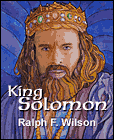 Available in book formats - PDF, Kindle, Paperback |
Prayer
Father, thank you for all your blessings, both material and spiritual. Please keep us from loving money and from the arrogance of those who don't lack for anything. Rather, build in us your value system of trust and generosity. In Jesus' name, we pray. Amen.
Lessons for Disciples
A review of Solomon's wealth sparks many lessons for disciples about how to view prosperity.
- Solomon's wealth and honor are clearly bestowed on him by God (1 Kings 3:13).
- Solomon serves his people by building up the defenses of Jerusalem and many outlying cities to protect Israel's homeland (1 Kings 9:10-28).
- Solomon gains wealth from tributes of vassal nations, tariffs on trade, and from the profit of his trading ventures with the Phoenicians (1 Kings 9:26-28; 10:14-15).
- The Queen of Sheba visits Solomon to learn from his wisdom (1 Kings 10:1-13). Jesus refers to it by saying of himself, "one greater than Solomon is here" (Luke 11:31). Jesus' wisdom is often paradoxical, counter to the world's wisdom. Christ is our wisdom (1 Corinthians 1:30; Colossians 2:2).
- Solomon's high throne of gold and ivory was impressive (1 Kings 10;18-20), but it is nothing compared to God's throne in heaven (Revelation 4:2-6; 20:12; 22:1, 3).
- In spite of God's blessing to Solomon, Deuteronomy 17:16-17 warns against kings acquiring horses, wives, and wealth. Great wealth comes with temptations.
- The Prosperity Gospel sees poverty as a curse and prosperity as a blessing. But Jesus teaches us not to focus on wealth or possessions, but to seek the Kingdom of God (Matthew 6:28-33). From those who have been given much, much is required (Luke 12:48).
- The Bible teaches almsgiving as a consistent practice, as does Solomon in the Book of Proverbs.
- Paul warns the rich against arrogance and putting their hope or trust in wealth. Rather, we are to seek to be "rich in good deeds," be generous, and to share (1 Timothy 6:17-19).
Endnotes
[193] Until the completion of his palace, Solomon is living in David's palace in the old city of David (1 Kings 3:1; 2 Chronicles 9:11).
[194] 1 Kings 10:17; Isaiah 22:8.
[195] 1 Kings 10:21; 2 Chronicles 9:20.
[196] K. A. Kitchen, "Pharoah's Daughter," ISBE 3:822. This view is supported in K.A. Kitchen, The Third Intermediate Period in Egypt (1100--650 BC) (3rd edition, Warminster: Aris & Phillips Ltd., 1998), p.423; Kaiser and Wegner, History, pp. 396-397. See also Philip D. Stern, "Solomon's Egyptian Bride: Artful Alliance or Biblical Boast," Biblical Archaeology Review, Vol. 50, No. 1, Spring 2024, pp. 61-62. https://www.biblicalarchaeology.org/egyptbride
[197] Wiseman, 1&2 Kings, p. 82.
[198] Kaiser and Wegner (History, p. 473) comment, "She was transferred from the sacred precincts of Zion to a palace on the opposite side of the Kidron Valley in order not to continue to offend the holiness of God." I don't find any support for a location east of the Kidron Valley.
[199]
Eilat Mazar, Discovering the Solomonic Wall in
Jerusalem: A Remarkable Archaeological Adventure (Jerusalem: Shoham
Academic Research and Publication, 2011); Mati Milstein,
"King Solomon's Wall Found--Proof of Bible Tale?"
National Geographic, February 27, 2010.
https://www.nationalgeographic.com/history/article/100226-king-solomon-wall-jerusalem-bible
[200] Walter C. Kaiser, millûʾ, TWOT #1195e. "Fill(ing)," construction built out on an (artificial) terrace for various purposes (Holladay, p. 197).
[201] "Built" is bānâ, "build, rebuild" (TWOT #255). "Filled in" is sāgar, "shut, close" (TWOT #1462). "Gap" is pereṣ, "breach," from pāraṣ, "to break (through, down, over)," used mostly of a breach or gap in a wall (TWOT #1826a; Isaiah 58:12; Amos 9:11; Nehemiah 6:1).
[202] P. L. Garber, "Millo," ISBE 3:361. G. E. Wright speculated that the Millo was a broad, solid-fill, raised platform built by Solomon as a causeway over a steep gully that had previously isolated the temple area from the Jebusite stronghold. See also William Sanford LaSor, "Jerusalem," ISBE 2:1006, III, C, 1c. Wiseman (1&2 Kings, p. 128) sees the Millo as a construction either (1) forming the extension of the stepped terrace and city wall on the east flank of the palace, or (2) a fill bridging the depression between Zion and Ophel. Recently, some archaeologists have identified it with the Gihon Spring Tower, a defensive structure to protect access to Jerusalem's water source at the Gihon Spring in case of siege (Chris McKinney, Aharon Tavger, Nahshon Szanton, and Joe Uziel, "The Millo: Jerusalem's Lost Monument," Biblical Archaeology Review, Fall 2023, pp. 35-41).
[203] Bright, History, pp. 222-223. He says, "One wonders if this could have been a popular transaction in Israel. In any event, when a state begins to sell off its territory, it is evident that its financial situation is parlous indeed."
[204] R. J. Hughes III, "Cabul," TWOT #1:567.
[205] The Babylonian talent that was probably used in ancient Israel weighed 129 pounds (58.9 kg) (Wikipedia article, "Talent (measurement).") In January 2024, the price of gold was about $2,000 USD per ounce, making one talent worth more than USD $4 million in today's money.
[206] Selman, 2 Chronicles, p. 345; Williamson (1&2 Chronicles, pp. 227-229) suggests a possible corruption in the text.
[207] Bright, History, p. 212.
[208] Wiseman, 1&2 Kings, p. 127.
[209] Bright, History, p. 213.
[210] A.F. Rainey, "Hazor," ISBE 2:638.
[211] A.F. Rainey, "Megiddo," ISBE 3:311.
[212] Some see this as Hamath, Hittite city on the Orantes River in Syria. Other see it as referring to the house of Zobah (so Septuagint). H. F. Vos, "Hamath-Zobah," ISBE 2:603. Williamson (1&2 Chronicles, p. 229-230) sees some kind of damage to the text.
[213] E.W.G. Masterman and J.F. Prewitt, "Beth-Horon," ISBE 1:469.
[214] J. F. Prewitt, "Baalath," ISBE 1:379.
[215] Both Tamar and Tadmor mean "palm," signifying an oasis in the desert. The translation Tamar is the reading of the Masoretic Hebrew text, and followed by the ESV, NRSV, NASB, and NJB. The translation Tadmor requires a slight emendation of the Hebrew text and is supported by the Greek Septuagint of 2 Chronicles 8:4 (which was based on the 1 Kings text), the NIV, and KJV. Butler argues that the correct reading is Tamar, an obscure town for technical reasons (J. T. Butler, "Tamar," ISBE 4:724-725). For more on this, see the commentaries.
[216] Tarshish has been variously identified as located in Spain or Sardinia in the western Mediterranean. The Bible records Tarshish as the source of beaten silver (Jeremiah 10:9), as well as silver, iron, tin and lead (Ezekiel 27:12) (William Sanford LaSor, "Tarshish," ISBE 4:734).
[217] The phrase "once every three years," means departure in one year, a year for business acquisitions, and then, after trading along the coasts of Arabia, India, or Africa, from which luxuries are brought, return in a third year (Wiseman, 1&2 Kings, p. 133).
[218] Wikipedia article, "Phoenicia."
[219]
"Ivory" is shēn, "tooth," and also "ivory" (1 Kings 22:39; Amos
3:15; 6:4; Ezekiel 27:6, 15; Psalm 45:9; Song of Solomon 5:14; 7:5) (TWOT
#2422a). The 14th century BC Uluburun (Grand Cape, Turkey) shipwreck
contains a cargo of one full and one partial elephant tusk and thirteen
hippopotamus teeth, as well as some carved ivories. The source can be narrowed
to Libya, Sudan, Egypt, Syria, and Palestine. A late 7th century BC
Bajo de la Campana shipwreck off the southeastern coast of Spain yielded 50
elephant tusks, probably from African forest elephants in western North Africa.
"Ivory Part 1: The Phoenicians," by "mand," in Steemit.com.
https://steemit.com/history/@mand/ivory-part-1-the-phoenicians
[220] "Apes" is qôp, (a foreign loan-word), "ape", or perhaps Hamadryas Baboon (Papio hamadryas; so Holladay, p. 316), a species of baboon within the Old World monkey family, native to the Horn of Africa and the southwestern region of the Arabian Peninsula. "Probably the reference is not to apes as such, which are tailless, but to monkeys or baboons, the latter being well known in Egypt" ("Ape," ISBE 1:149). In the second half of the ninth century (a century later than Solomon), the Phoenicians establish the colony of Carthage in North Africa (modern-day Tunisia), which becomes a major trading power in its own right, and exports precious metals, slaves, agricultural products, as well as manufactured goods, such as fine cloths, pottery, and jewelry.
[221] "Baboons" (NIV, NJB), "peacocks" (ESV, NRSV, NASB, KJV) is tūkkîyîm, "peacock" (BDB), "baboon, ape" (KB, from the Egyptian) (TWOT #2208). There are two theories of the derivation of the Hebrew tūkkîyîm: (1) From the Egyptian word ky, "baboon" (so W. F. Albright; Holladay, p. 390); and (2) from word tokei in Tamil, the language spoken in southern India. Two species of peafowl are found in southeastern Asia. The Green Peacock (Pavo muticus) is found in southeast Asia and Indochina. It is the national bird of Myanmar. The Indian Peafowl (Pavo cristatus) is the more beautiful of the two, found in the jungles of India and Ceylon (G. Wyper, "Peacock," ISBE 3:733).
[222] Cited in Kaiser and Wegner, History, p. 409. I couldn't find the reference online.
[223] "The gold 'brought back' (lāqaḥ) implies exchange for goods traded" (Wiseman, 1&2 Kings, p. 129).
[224] E. M. Cook, "Ophir," ISBE 3:608.
[225] Bright, History, p. 215. For a thorough discussion, see Francisco del Rio Sanchez, "Where Did the Queen of Sheba Rule -- Arabia or Africa?" National Geographic, website, 7 Jun 2021. https://www.nationalgeographic.co.uk/history-and-civilisation/2021/06/where-did-the-queen-of-sheba-rule-arabia-or-africa
[226] R. K. Harrison, "Algum," ISBE 1:94. Holladay (p. 18), "traditionally sandalwood, but this does not occur in Lebanon, other Juniperus phoenicea.
[227] 1 Kings 10:2, 10; Isaiah 60:6; Jeremiah 6:20; Ezekiel 27:22. William Sanford La Sor, "Sabeans," ISBE 4:254.
[228] David A. Hubbard, "Queen of Sheba," ISBE 4:8-9.
[229] Ryken (Solomon, p. 145) notes, "The queen of Sheba was curious about Solomon.... Frankly, she did not quite believe the reports she had received. She was a skeptic of the healthiest kind: although she did not believe everything she heard, she was always open to believing the truth."
[230] Wiseman, 1&2 Kings, p. 129.
[231] The Chronicler makes an interesting but subtle change, attributing the throne not to Israel, but to Yahweh. "Praise be to the Lord your God, who has delighted in you and placed you on his throne as king to rule for the Lord your God" (2 Chronicles 9:8). The Chronicler recognizes that Israel's kings rule over his people on behalf of Yahweh, who is the real King.
[232] In 2012, archaeologist Eliat Mazar discovered a seven-letter inscription on a piece of pottery, apparently written in an Ancient South Arabian script known as Sabaic, the language of biblical Sheba, dating from the tenth century -- Solomon's time. This seems to provide archaeological support for trade between Sheba and Israel (Nathan Steinmeyer, "Archaeological Evidence of Solomon and Sheba?" Bible History Daily, 10 April 2023.
[233] Wiseman (1&2 Kings, p. 130) suggests that "the quantities involved here could well imply a trade mission."
[234] "Lifestyles of the Rich and Famous" is the name of an American television series that aired in syndication from 1984 to 1995.
[235] Wikipedia article, "Arabian-Nubian Shield."
[236] Wikipedia article, "Talent (measurement)."
[237] H. W. Perkin, "Money," ISBE 3:403.
[238] T. Nichol, "Chariot," ISBE 1:635.
[239] Tarshish has been variously identified as located in Spain or Sardinia in the western Mediterranean (William Sanford LaSor, "Tarshish," ISBE 4:734).
[240] Merriam-Webster Collegiate Dictionary, 11th Edition.
[241] Leviticus 19:9-10; 23:22; Deuteronomy 24:19-21; Ruth 2:2-23.
[242] Solomon is attributed as the author of Proverbs 10:1-22:16 and Proverbs 25:1-29:27.
[243] See also Proverbs 14:21, 31; 31:20. The Jewish apocryphal book of Tobit included in Catholic and Anglican Bibles encourages observant Jews to give alms in proportion to one's means: "If you have many possessions, make your gift from them in proportion; if few, do not be afraid to give according to the little you have" (Tobit 4:8). Tobit is a Jewish moralistic story that speaks of events of the 8th to 7th centuries BC, but may have been written as late as the 2nd or third centuries BC (P. L. Redditt, "Tobit," ISBE 4:866-868).
[244] For example, Romans 15:16; 2 Corinthians 8-9; Galatians 2:10.
[245] Ralph F. Wilson, "A Brief Critique of the Prosperity Message," (https://www.jesuswalk.com/2corinthians/prosperity-message.htm). The Prosperity Gospel seems to have begun in America, but has spread widely. It saddens me to learn that a number of the leading Prosperity Gospel in Nigeria have personal wealth in the tens of millions of dollars and often one or more personal jet aircraft.See Peris Walubengo Adrianna Simwa, "Top 13 richest pastors in Nigeria in 2024: background, net worth, and cars," Legit.ng, updated 5 Dec 2023 (https://www.legit.ng/ask-legit/top/1086659-top-richest-pastors-nigeria/).
[246] There seems to be humility in Solomon's early prayer for wisdom (1 Kings 3:7) and in Ecclesiastes, if he is the author.
[247] This is similar to the idea expressed in the French phrase, noblesse oblige (literally, "nobility obliges"), "the obligation of honorable, generous, and responsible behavior associated with high rank or birth" (Merriam-Webster 11th Collegiate Dictionary). Except that in Christ's Kingdom, it isn't just the elite who need to give back; we are all brothers and sisters of the King.
[248] "Splendor" (NIV), "glory" (ESV, NRSV, KJV) is Greek doxa, "glory," here, "a state of being magnificent, greatness, splendor, anything that catches the eye" (BDAG 257, 2).
Copyright © 2025, Ralph F. Wilson. <pastor![]() joyfulheart.com> All rights reserved. A single copy of this article is free. Do not put this on a website. See legal, copyright, and reprint information.
joyfulheart.com> All rights reserved. A single copy of this article is free. Do not put this on a website. See legal, copyright, and reprint information.

